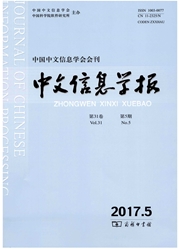

 中文摘要:
中文摘要:
OCR(光学字符识别技术)作为方便有效的字体识别技术,在办公自动化、信息恢复、数字图书馆等方面发挥着日益重要的作用。语言模型在OCR后处理,特别是在中文的文字识别后处理方面有着广泛的应用。本文针对手写中文地址的后处理,讨论了语言模型的粒度对识别正确率的影响,分析了基于字和基于词的语言模型各自的优点和缺点,并采用了基于词的语言模型,在此基础上提出了加权词图搜索算法。实验证明,在58269条中文手写地址的测试集上,手写地址的整体识别率由原来的28.56%上升到了75.66%.错误率下降了65.93%,大大提高了系统的性能。
 英文摘要:
英文摘要:
OCR(Optical Character Recognition), a convenient and efficient automatic character recognition tool, is becoming more and more important in office automation, information recovery and digital library. Language Model is widely used in OCR post-processing, especially in Chinese. In this paper, we focus on the post-processing of handwritten Chinese addresses, and discuss the relationship between the granularity of language model and system performance. The character-based and the word-based language models are both discussed. Their advantages and disadvantages are also presented. After analysis, the word-based language model is adopted, and then weighted word graph and its algorithm are proposed. Experiments on 58269 handwritten Chinese addresses show that the performance of the OCR system has been greatly improved and the recognition precision increases from 28.56% to 74. 15%, which means 63.82% error reduction.
 同期刊论文项目
同期刊论文项目
 同项目期刊论文
同项目期刊论文
 期刊信息
期刊信息
